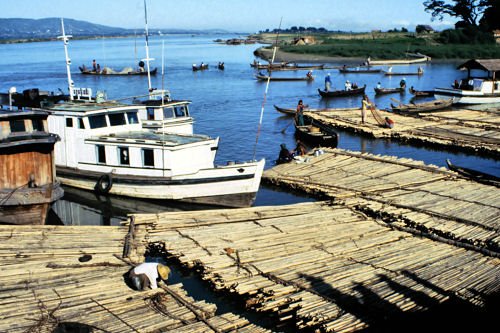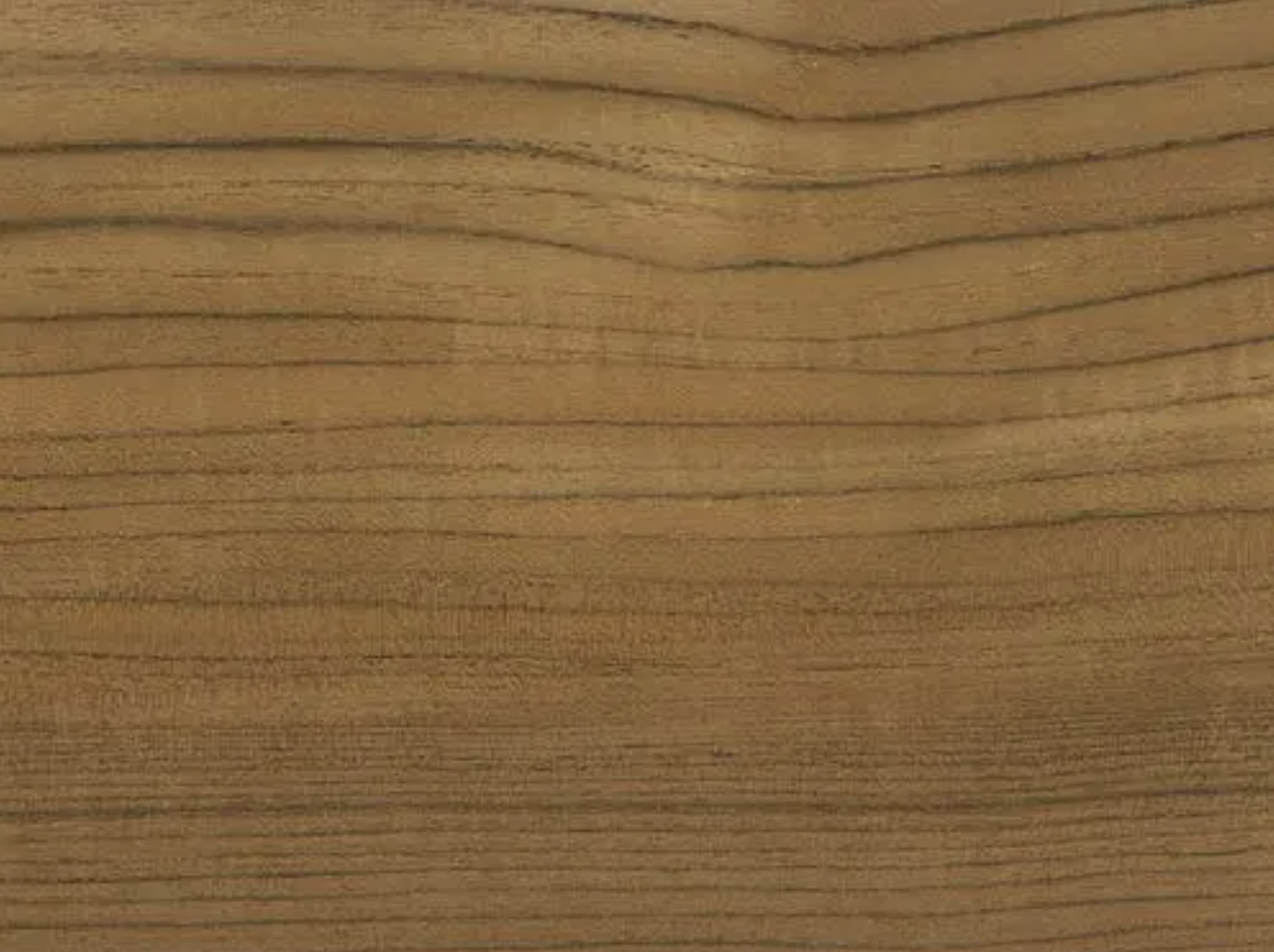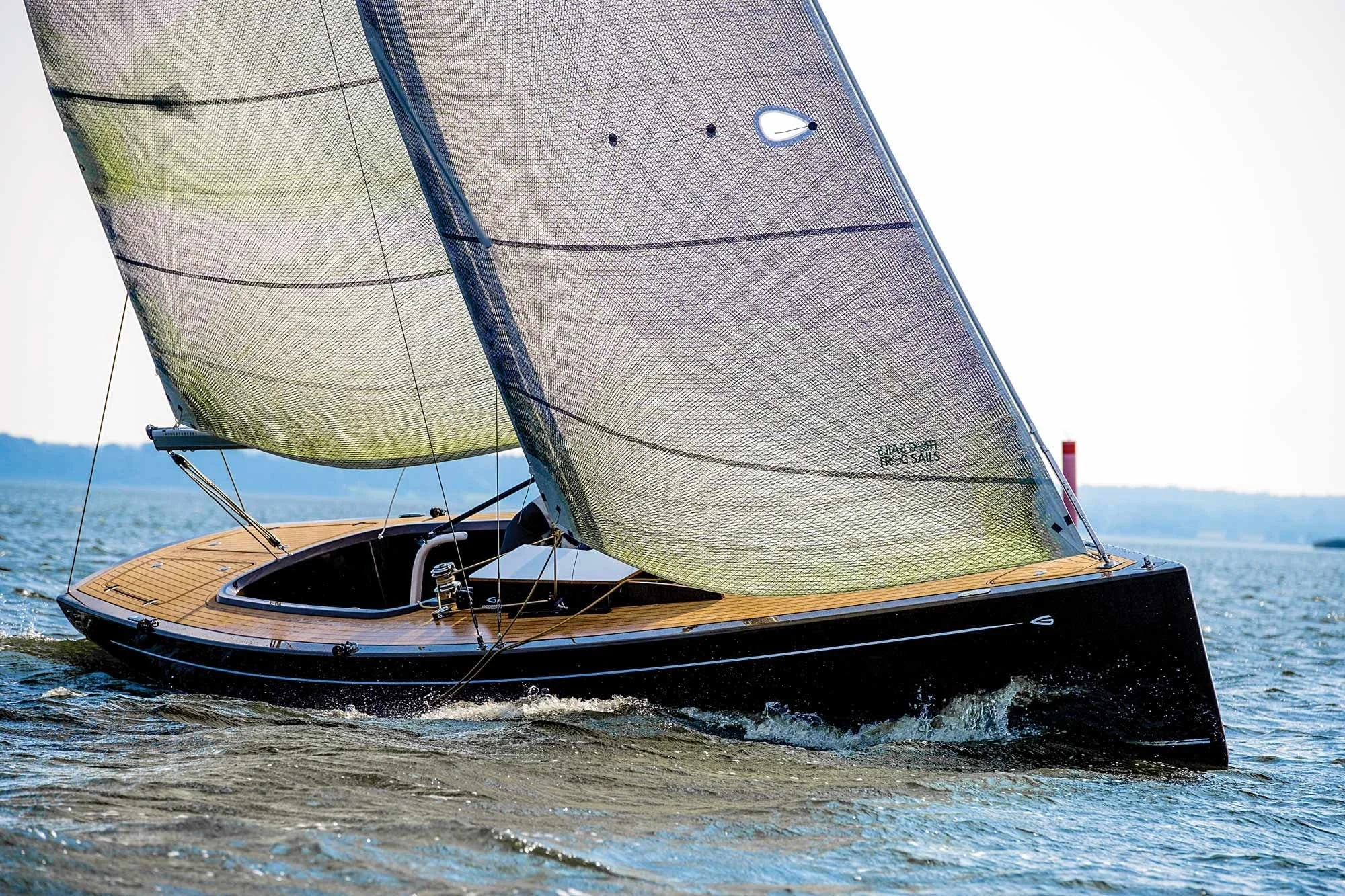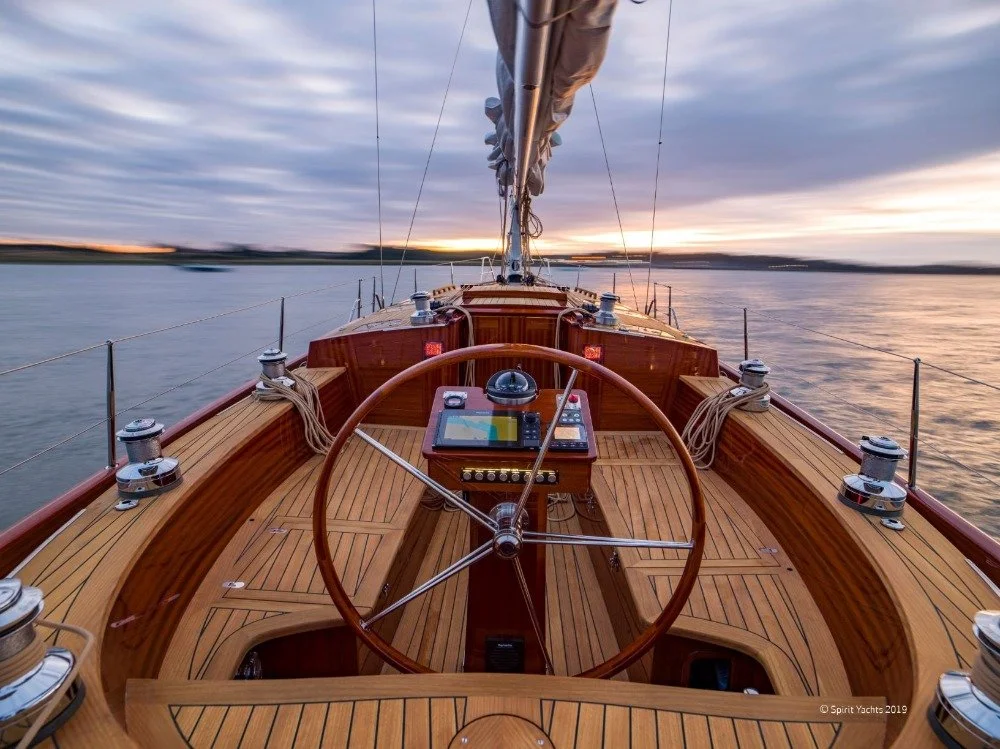Has Teak Peaked?
by Craig Ritchie
Rafted teak logs on the Irrawaddy River
For generations teak has been the gold standard for boat decks. But mounting concerns about the over-harvest of old-growth forests and advances in recyclable synthetic alternatives have given today’s boat buyers legitimate options and plenty to think about.
Straight-grained, devoid of knots, beautiful to look at and blessed with natural oils that leave it highly resistant to warping or rotting in even the harshest saltwater environments, teak’s position as the world’s premiere decking material is well-deserved – and a big reason why it’s still held in such high esteem among boat buyers.
But teak’s positive qualities also come with a range of caveats. Its high (and growing) cost, along with mounting concerns about the sustainability of the old-growth teak harvest have left boatbuilders and boaties looking increasingly to alternative decking materials. Some of these modern alternatives not only compete favourably against teak, but offer real advantages over the old gold standard.
The very best teak comes from the old-growth forests of Myanmar. There, an ideal balance of soil chemistry and drainage, along with a perfect climate with just the right mix of temperatures, rainfall and humidity, create a unique environment where teak trees thrive. Teak from this region has been harvested for centuries.
“Girdling” a tree to kill it in the 1920’s
Elephant removing logs from the river in the 1920’s
The trees which yield the best teak are old – at least 50 but preferably closer to 100 years of age. It was all fine and well when the world built a few thousand new boats each year. But over the last century as global boat production surged into the tens of thousands of decks every year, demand for teak grew to the point where harvesters began felling trees faster than they could grow back.The harvest of teak accelerated further about 15 years ago when Myanmar’s military-led government allowed vast swathes of old-growth forest to be levelled – a move accompanied by widespread allegations that the administration was in fact being funded by black market wood sales.
That situation changed in 2011 when the military leadership was replaced with a democratically-elected government, but decades of over-harvest had already taken its toll.
[Editor’s Note: Shortly after this article was first published last year, Myanmar experienced a coup d'état on the morning of 1 February 2021, when democratically elected members of the country's ruling party, the National League for Democracy (NLD), were deposed by the Tatmadaw—Myanmar's military—which then vested power in a stratocracy. There are widespread reports that over 1500 protestors have died since then, and the effect on the teak trade is hard to gauge]
Today, Myanmar’s teak trade is tightly controlled, with clear harvest limits enforced aggressively. Still, that doesn’t stop so-called teak poachers cutting trees illegally. “We can still source Myanmar teak, but getting legally-harvested teak is the challenge,” says Richard Strauss, president of Teakdecking Systems.
“We have to work hard to ensure all of the proper provenance is in place and that our wood traders are providing all the correct documentation. It’s very expensive but we can obtain old-growth teak for those customers who want the absolute crème de la crème.”
Strauss says in recent years the market’s been supplemented by farmed teak produced in central American countries. “We’ve sourced plantation teak from there, and even from Sri Lanka, but it’s just not the same,” says Strauss. “The soil and the climate there are different enough that you don’t get the same tightness in the grain, or anywhere near the same quality consistency.
“But demand greatly exceeds the supply, which has an obvious impact on prices. That’s why we encourage people to use teak wisely. This means that rather than loading a boat with the stuff from top to bottom, use it where it will make a real impact, such as on a salon floor.
“Then go with composite decking elsewhere, and especially in places like inside the tender garage and up on the bow around the ground tackle and anchoring equipment, where the deck can get beat up. There’s no need to use real teak in those kinds of locations.”
But the reduced availability and rising cost are only part of the reason for a shift away from teak in production boats and, to a lesser extent, in luxury yachts. A new cohort of younger buyers may relish the look of teak, says Strauss, but not the requisite upkeep.
“Society now demands products that are easier to maintain,” he notes. “Around the world we have more new money and younger buyers, and the bottom line is that they just don’t want to deal with the maintenance that goes hand-in-hand with a real teak deck.”
TEAK ALTERNATIVES – ALTERNATE WOODS
Teak is not the only type of wood riding the waves these days. Some boat builders have begun experimenting with alternatives – like cork.
European boatbuilders began experimenting with cork decks a few years ago following the launch of the Flax 27 Daysailer from Greenboats in Germany, built from 80% sustainable materials and fitted with cork decks.
Flax 27 Daysailer
Citing the material as being lighter, better insulating and harder-wearing than teak with superior anti-slip properties, Els Zijlstra says that the outer bark layer of a cork tree can be sustainably removed every seven years. As a deck material, she says cork beats teak by being more fire resistant, more antibacterial and offering better sound insulation.
A number of European manufacturers now offer cork decks as an alternative to teak, and products such as SeaCork, Oceancork and Marinedeck 2000 have attracted interest from boatbuilders worldwide. Most use a formula that consists of about 95% ground cork with a polyurethane binder representing the remaining five percent of its volume. Cork decks are most often sold in rolls, either with grooves that simulate the appearance of a caulked teak deck, or in plain sheets without the grooves. They’re available in a wide range of colours.
Other companies have begun experimenting with engineered woods as a teak alternative. At the 2019 METS trade show in Amsterdam UK-based Lignia Wood Company won a coveted DAME Design Award for its FSC-certified softwood decking.
The deck of a Spirit Yacht 50 in Lignia Engineered wood
Harvested from fast-growing, sustainably-managed forests, Lignia engineered wood decks start off as quartersawn softwood which is enhanced for durability through a proprietary process that results in a tough, durable deck material. In independent testing, the material has been proven to equal or exceed the properties of Burmese teak, and can withstand fungal decay and rot for at least 60 years in service. Lignia’s engineered decking has comparable weight and bonding characteristics to teak, and can have various types of stain or varnishes applied to it.
TEAK ALTERNATIVES – ENGINEERED COMPOSITES
Initially developed to closely mimic the appearance of teak but now available in a wide range of finishes, engineered composites have gained considerable traction among boatbuilders and buyers in recent years, and for reasons that go far beyond wider availability and lower cost.
For starters, fake teak comes in wide sheets, not individual wood strips, so it’s a lot easier and less expensive to install. “The boatbuilder sends us a CAD drawing or a physical template for the deck, and we produce the decking to fit,” says Chad Adams, product manager with Flexiteek. “Once it’s been fabricated, the deck can be rolled up like a carpet and shipped by courier. The material comes out as a perfect fit every time, and it’s easily repeatable, which is an enormous benefit for production boatbuilders.”
Flexiteek on a Grand Soleil 52
The biggest benefit to engineered panels, he adds, is their ease of installation by factory workers of moderate skill, which greatly reduces the cost of the finished boat. “Teak is a natural material and as a result there are always variances from one strip of wood to the next. So to install a teak deck, or any kind of wood deck, you need a highly skilled master carpenter to fit the individual pieces together and deal with any adjustments needed to get that perfect fit. It’s a slow, tedious process.
“By comparison, our Flexiteek G2 deck looks exactly like real teak but it rolls into place, and it’s very easy to accommodate any small adjustments that might be required during the installation. You’re talking minutes instead of days.”
While boaties appreciate the lower cost of engineered decking, even more attractive is the reduced maintenance and greater ease of repair from accidental damage. More colour options, including light grey styles, have proven popular on sailboats and production runabouts, allowing a greater variety of appearance options.
With increasing numbers of younger buyers entering the global boat market, Adams says engineered decks offer even further appeal as a more ecologically- responsible alternative to natural woods. Now there’s an unusual thought – a manufactured deck being more sustainable than something that actually does grow on trees?
“Unlike a teak deck, our engineered Flexiteek deck is recyclable at the end of its service life,” he says. “Over time a wood deck just gets sanded away and turns into dust. But when the end comes for our deck, it can be ground up and made into something else. You can’t do that with actual teak.”
Recyclability is also a key consideration for synthetic decking manufacturer PlasTeak, which won an Innovation Award at the 2018 Miami International Boat Show for its Eco Series decking made from 60% post-industrial recycled material.
“We were taking all of our end cuts and scrap pieces, grinding them back up and re-using them with a top layer of virgin material,” says PlasTeak president, William Gribble. “We’re not only telling people the material is recyclable – we’re actually doing it ourselves. We all like to talk about a circular economy, where materials have value at the end of their lives and can be made into something else. That’s what we do with PlasTeak, you can re-use it instead of having to go chop down more trees.”
The other benefit to engineered composite decks is lighter weight – up to half that of real teak. For powerboats, that can translate into a considerable long-term improvement in fuel economy while both sail and power vessels can benefit from improved performance and more nimble handling.
TEAK ALTERNATIVES – SYNTHETICS
Where fibreglass non-skid and marine carpet once dominated the decks of boats under 40 feet, today the floor coverings found on production boats are largely formed from synthetics, including both sheet and rolled vinyl.
“The main benefits to vinyl are that it’s easy to install, it requires absolutely zero maintenance and it’s way tougher than real wood,” says Gregg Nord, sales manager with flooring manufacturer Lonseal. “The installer is dealing with single continuous sheets of flooring instead of endless little strips of teak, so it’s a lot less expensive to install.
“It’s completely waterproof, it requires no maintenance, and the fact that it’s a commercially-rated product designed for office buildings and shopping malls makes it almost overkill in a boat, but customers want the zero-maintenance and the incredible durability it offers.”
Nord notes that while Lonseal does brisk business supplying decking to major boatbuilders, the refit market has come to represent a substantial portion of its overall sales today. “We’re increasingly seeing it used to replace real teak,” he says, “because it eliminates maintenance.
“Boat owners have a limited amount of time they can spend on their boat, and they generally don’t want to spend it refinishing teak floors or redoing caulking that’s dried and popped out. The only real maintenance on our floor is to run over it with a mop it now and then.”
Indeed, Nord says one of the greatest attributes of vinyl flooring is its ability to resist damage from fuel spills, oil spills or foods like red wine or mustard, all of which can stain teak floors. “It simply wipes clean and at the same time it’s soft underfoot with great non-slip qualities – especially important when you have a boatload of kids.”
Super-light weight is yet another major vinyl benefit. “It’s widely used on aircraft floors for a reason,” says Nord.
TEAK ALTERNATIVES – CLOSED-CELL FOAM
Among all synthetic decking materials, closed-cell PE/EVA foam is hands-down the easiest to distinguish from real teak. But even though it won’t fool anyone, foam decks offer a number of appealing attributes over real wood, including a soft, cushy feel under foot, zero maintenance and for anglers, outstanding sound-dampening qualities.
Further, closed-cell foam completely sheds water while offering terrific traction for even wet feet, which is a big reason for its widespread use on swim platforms and its near-universal adoption among builders of watersports tow boats.
Increasingly, foam is being used to replace teak on the decks of sailboats, and particularly on racing vessels where its exceptional durability, non-skid properties and light weight (that contributes to higher speeds) have won it widespread accolades.
But cruisers also appreciate its durability, along with the lack of any requirement for regular maintenance. For travel writers Bryan and Giselle Taylor, being able to spend all of their time enjoying their boat rather than refinishing the deck gives foam flooring a huge edge over natural wood. “We literally spray it off and walk away,” says Giselle. “When they say low maintenance, they really mean zero, as in none whatsoever.”
That’s also why foam decks have found such uptake among fishos, who simply blast away any fish scales or slime with a quick squirt from the transom shower. While classic offshore boats with teak decks and fighting chairs may look grand when parked at the slip, they’re steadily giving way to foam and vinyl decking in the real world.
Richard Strauss says real teak decks aren’t about to disappear altogether, and particularly on high-end luxury yachts where cost is not a consideration. As much as younger buyers appreciate the greater ecological sustainability of recyclable decking over natural wood, there’s also a market for the authenticity that only a genuine teak deck provides.
Charles E. Nicholson’s MERRYMAID’s resplendant real teak decks. Yours for only EUR 4,950,000
But on the vast majority of pleasure craft, fishing boats and sailboats, engineered teak alternatives are expected to continue replacing natural wood on the strength of their durability, lack of maintenance requirement and ability to be recycled. “And more than anything else,” says Chad Adams, “they just look and feel great.”
//
EDITOR - This article was first published in Boating NZ - many thanks








